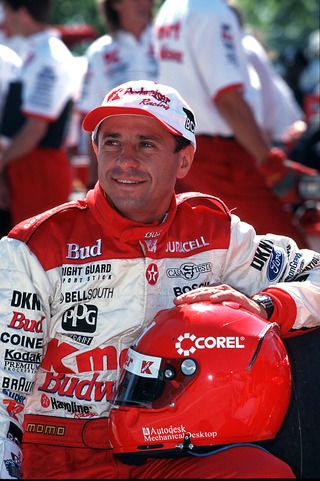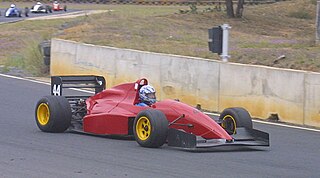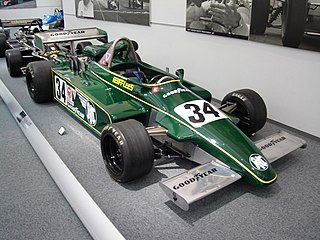Motor Racing Developments Ltd., commonly known as Brabham, was a British racing car manufacturer and Formula One racing team. It was founded in 1960 by the Australian driver Jack Brabham and the British-Australian designer Ron Tauranac. The team had a successful thirty-year history, winning four FIA Formula One Drivers' and two Constructors' World Championships, starting with two successive wins in 1966 and 1967. Jack Brabham's 1966 Drivers' Championship remains the only such achievement using a car bearing the driver's own name.

The Formula 3000 International Championship was a motor racing series created by the Fédération Internationale de l'Automobile (FIA) in 1985 to become the final preparatory step for drivers hoping to enter Formula One. Formula Two had become too expensive, and was dominated by works-run cars with factory engines; the hope was that Formula 3000 would offer quicker, cheaper, more open racing. The series began as an open specification, then tyres were standardized from 1986 onwards, followed by engines and chassis in 1996. The series ran annually until 2004, and was replaced in 2005 by the GP2 Series.

Formula Two is a type of open-wheel formula racing category first codified in 1948. It was replaced in 1985 by Formula 3000, but revived by the FIA from 2009–
Lola Cars Limited is a British automobile manufacturer founded in 1958 by Eric Broadley in Bromley, England. The company is now owned by Till Bechtolsheimer, which he purchased in 2022. Lola Cars endured for more than fifty years to become one of the oldest and largest manufacturers of racing cars in the world. Lola started by building small front-engined sports cars, and branched out into Formula Junior cars before diversifying into a wider range of sporting vehicles. In 2012, Lola Cars stopped operations. The company is set to make a return to motorsport in 2024 by joining the Formula E World Championship.

Roberto Pupo Moreno, usually known as Roberto Moreno and also as Pupo Moreno, is a Brazilian former racing driver. He participated in 75 Formula One Grands Prix, achieved 1 podium, and scored a total of 15 championship points. He raced in CART in 1986, and was Formula 3000 champion before joining Formula One full-time in 1989. He returned to CART in 1996 where he enjoyed an Indian summer in 2000 and 2001, and managed to extend his career in the series until 2008. He also raced in endurance events and GT's in Brazil, but now works as a driver coach and consultant, and although this takes up a lot of his time, he is not officially retired yet, as he appears in historic events. Away from the sport, he enjoys building light aeroplanes.
March Engineering was a Formula One constructor and manufacturer of customer racing cars from the United Kingdom. Although only moderately successful in Grand Prix competition, March racing cars enjoyed much better success in other categories of competition, including Formula Two, Formula Three, IndyCar and IMSA GTP sportscar racing.

Formula Holden was an Australian open wheel racing category introduced in 1989.

Judd is a brand of racing car engines built by Engine Developments Ltd., a company founded in 1971 by John Judd and Jack Brabham in Rugby, Warwickshire, England. Engine Developments was intended to build engines for Brabham's racing efforts, and became one of the first firms authorised by Cosworth to maintain and rebuild its DFV engines, but has since expanded into various areas of motorsport.

Ronald Sidney Tauranac was a British-Australian engineer and racing car designer, who with Formula One driver Jack Brabham founded the Brabham constructor and racing team in 1962. Following Brabham's retirement as a driver at the end of the 1970 season, Tauranac owned and managed the Brabham team until 1972, when he sold it to Bernie Ecclestone. He remained in England to assist with a redesign of a Politoys Formula One chassis for Frank Williams in 1973 and helped Trojan develop a Formula One version of their Formula 5000 car.

The Brabham BT19 is a Formula One racing car designed by Ron Tauranac for the British Brabham team. The BT19 competed in the 1966 and 1967 Formula One World Championships and was used by Australian driver Jack Brabham to win his third World Championship in 1966. The BT19, which Brabham referred to as his "Old Nail", was the first car bearing its driver's name to win a World Championship race.

The Repco Brabham BT24 was a Formula One racing car design. It was one of three cars used by the Brabham racing team during their championship-winning 1967 Formula One season. Only three BT24 chassis were ever raced.
John Judd is a Formula One engineer from England. He is the boss of Engine Developments Ltd., manufacturers of Judd engines. He is also known for his partnership with triple F1 World Champion Sir Jack Brabham.

The Ralt RT3 is an open-wheel Formula 3 race car, developed and built by Ralt in 1979.

The Brabham BT3 is a Formula One racing car. It was the first Formula One design to be produced by Motor Racing Developments for the Brabham Racing Organisation, and debuted at the 1962 German Grand Prix. The Brabham BT3 was the vehicle with which team owner – then two-time World Champion – Jack Brabham, became the first driver ever to score World Championship points in a car bearing his own name, at the 1962 United States Grand Prix. The following year Brabham also became the first driver ever to win a Formula One race at the wheel of an eponymous car, again driving the BT3, at the 1963 Solitude Grand Prix. The BT3 design was modified only slightly to form the Tasman Series-specification Brabham BT4 cars.

The fifth Gran Premio de Madrid, was the seventh round of the 1983 European Championship for F2 Drivers. This was held at Circuito Permanente del Jarama, north of the Spanish capital, Madrid, on 12 June. This was first time the race was held since 1971.

The Honda turbocharged Indy V8 engine is a single-turbocharged, 2.65-liter, V-8 Indy car racing engine, originally designed, developed and produced by Honda, in partnership with Judd, for use in the CART championship series between 1986 and 2002.
The Swift DB4 is an open-wheel formula racing car chassis, designed, developed and built by American Company Swift Engineering, for the Formula Atlantic spec-series, between 1987 and 1997. It won the championship five times, with four championships won four consecutive years in a row. It was powered by naturally aspirated 1.6 L (98 cu in) Toyota 4A-GE four-cylinder engine, producing about 240 hp (180 kW), which drove the rear wheels through a standard 5-speed manual transmission.
The Ralt RT2 is an open-wheel ground effect formula racing car, designed, developed and built by Ralt, for Formula Two racing categories, in 1979.

The Ralt RH6 is an open-wheel formula racing car chassis, designed, developed and built by Australian constructor and manufacturer Ralt, for Formula Two racing categories, in 1980. It saw continued use in motor racing through 1984.
The Honda RA260E is a four-stroke, naturally-aspirated, 2.0-liter, V6 racing engine, designed for Formula 2, which was built and developed by Honda Motor Co., Ltd, for Formula 2 racing, in 1980.




















